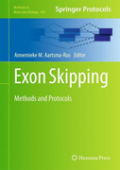
“Next generation” sequencing techniques allow for more detailed analysis of exons and introns in multiple genes at the same time. This will reveal many mutations that potentially lead to exon skipping. To functionally test these a lot can be achieved with a limited set of protocols, while for the intentional induction of exon skipping different tools and target genes are involved and the translational path from in vitro splicing to in vivo tests in animal models requiring a more extensive set of protocols. Exon Skipping: Methods and Protocols provides scientist with a comprehensive guide to many of the methods and techniques used for exon skipping, such as methods on how to discriminate “real polymorphisms” from mutations that affect splicing. Written in the highly successful Methods in Molecular Biology™ series format, chapters include introductions to their respective topics, lists of the necessary materials and reagents, step-by-step, readily reproducible laboratory protocols, and key tips on troubleshooting and avoiding known pitfalls. Authoritative and practical Exon Skipping: Methods and Protocols seeks to aid scientists in the continuing studyof exon skipping. Provides an overview of the exon skipping field. Provides step-by-step detail essential for reproducible results. Contains key notes and implementation advice from the experts. INDICE: DNA Diagnostics and Exon Skipping.-Bioinformatics and Mutations Leading to Exon Skipping.-Minigenes to Confirm Exon Skipping Mutations.-Analysisand Interpretation of RNA Splicing Alterations in Genes Involved in Genetic Disorders.-Exon Skipping Mutations in Neurofibromatosis.-Overview on Applications of Antisense-mediated Exon Skipping.-Overview on DMD Exon Skipping.-Overview on AON Design.-Optimizing RNA/ENA Chimeric Antisense Oligonucleotides Using in vitro Splicing.-Optimizing Antisense Oligonucleotides using Phosphorodiamidate Morpholino Oligomers.-Optimizing Splice Switching Oligomer Sequences using2’-O-methyl Phosphorothioate Chemistry.-Exon Skipping Quantification by Real Time PCR.-Antisense-mediated Exon Skipping to Shift Alternative Splicing to Treat Cancer.-Antisense-mediated Exon Skipping to Generate Soluble Receptors.-Antisense-mediated Exon Skipping to Reframe Transcripts.-U1 snRNA as an Effective Vector for Stable Expression of Antisense Molecules andfor the Inhibition ofthe Splicing Reaction.-Engineering U7snRNA Gene to Reframe Transcripts.-Dynamic Fluorescent and Luminescent Reporters for Cell Based Splicing Screens.-Antisense-mediated Exon Skipping to Induce Gene Knockdown.-Antisense-mediated ExonInclusion.-Antisense Genes to Induce Exon Inclusion.-Using Mini-genes to Identify Factors that Modulate Alternative Splicing.-Overview of Alternative Oligonucleotide Chemistries for Exon Skipping.-Identification of Peptides for Tissue Specific Delivery. -Systemic Delivery of Antisense Oligomer in Animal Modelsand its Implications for Treating DMD.-Cell-penetrating Peptides Enhance Systemic Delivery of Antisense Morpholino Oligomers.-Optimizing Tissue-specific Antisense Oligonucleotide-peptide Conjugates.
- ISBN: 978-1-61779-766-8
- Editorial: Humana Press
- Encuadernacion: Cartoné
- Páginas: 498
- Fecha Publicación: 30/04/2012
- Nº Volúmenes: 1
- Idioma: Inglés
